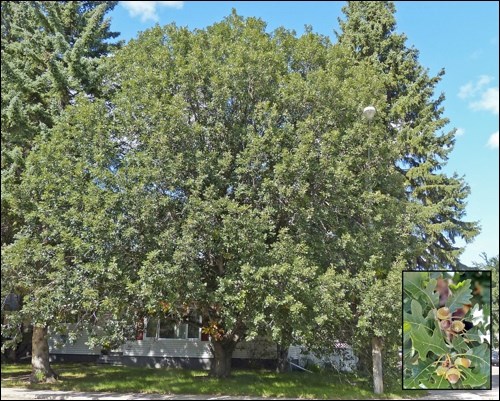I’ve never been ashamed of being a tree hugger. After almost four decades, I still pause and reflect on the beauty of the trunks and orange peeling bark of Scots pines as I enter my driveway. For a metropolitan city in the midst of a treeless prairie, Saskatoon is fortunate to have such a large, diverse and healthy urban forest – much of it planted almost a century ago by individuals with foresight who will for the most part remain anonymous. But their legacy is with us.
The new full-colour edition of the Saskatoon Tree Tour booklet tells the story of 25 of Saskatoon’s largest and oldest trees, including the ones mentioned below. To find out where you can obtain a free copy, go to the SOS Elms website: www.soselms.org/.
Among the oldest and largest trees in our city are the American elms (Ulmus americana), some of which are approaching 100 years old. Elms are the most common mature street tree in Saskatoon’s older neighbourhoods. Along with the magnificent canopies that arch over Poplar Crescent and Saskatchewan Crescent, there is also a huge elm in the 700 hundred block of Temperance Street. They have a lifespan of 300 years or more but are, unfortunately, at risk of being killed by Dutch Elm Disease.
In the 300 block of Saskatchewan Crescent West is a lovely hackberry (Celtis occidentalis), considered the “elm alternative” in that it is in the same family but immune to Dutch Elm Disease. Hardy, adaptable to many soil types as well as urban pollution, hackberry is native to the southern shore of Lake Manitoba. Large and lovely, it is slow growing. It’s not for those who demand instant gratification, but we plant trees for future generations, right?
One of the largest trees in Saskatoon is the Plains cottonwood (Populus deltoides) in the 200 block of 8th Street East. Its diameter is more than five feet at chest height. True sentinels of southern Saskatchewan, they have provided shade for weary travelers for centuries. They’re fast growing, but generally too large for urban yards.
In the 200 block of Poplar Crescent is a much smaller tree, the butternut (Juglans cinerea) with an edible nut related to the walnut. It does well along the riverbank and is well worth trying in more protected locations
Bur oak (Quercus macrocarpa) has long been one of my favourites. A symbol of strength and durability, it has a deep taproot, a stout trunk, handsome deeply lobed foliage and good fall colour. Look for a venerable example in the 900 block of Temperance Street. It does best in sandy well-drained soil.
If you’re after a shade tree with a dense rounded canopy and large, showy cream-coloured flowers, consider the Ohio buckeye (Aesculus glabra), a fine example of which can be seen in the 1300 block of Cascade Street. The common name comes from the resemblance of the large glossy seed (enclosed by a green prickly fruit) to the eye of a male deer coupled with Ohio being part of its native range. The nut is poisonous – not something to roast by the fire. The leaves are distinctive — palmately compound and a brilliant orange in the autumn.
The Amur cork tree (Phellodendron amurense) is a small, slow growing tree well suited to an urban residential lot. It’s about the size of a Siberian crabapple with attractive cork-like bark. A beautiful sample of this unique tree can be seen in the 2000 block of Haultain Avenue.
SOS Elms is charitable organization. It was founded in 1992 in response to the threat of Dutch Elm Disease as “a voice for our city’s urban forest in general and its American elms in particular.” Information about SOS membership (only $10 per year), its mandate and events can be found on the website. In collaboration with the City of Saskatoon’s Urban Forestry Division, SOS Elms will be giving a public information session on DED in June. Details will be on their website.
Sara will be offering a garden tour of England in May 2016. For more information contact Ruth at ruth@worldwideecotours.com or 888-778-2378.
— This column is provided courtesy of the Saskatchewan Perennial Society (www.saskperennial.ca; hortscene@yahoo.com; NEW www.facebook.com/saskperennial). Check out our Bulletin Board or Calendar for upcoming garden information sessions, workshops and tours: March 23, 7:30 – Irises (with Brian Porter) at Emmanuel Anglican Church, Saskatoon.



